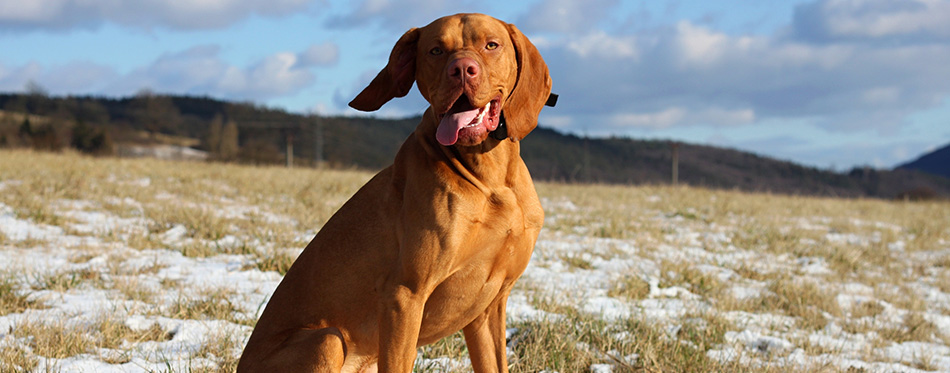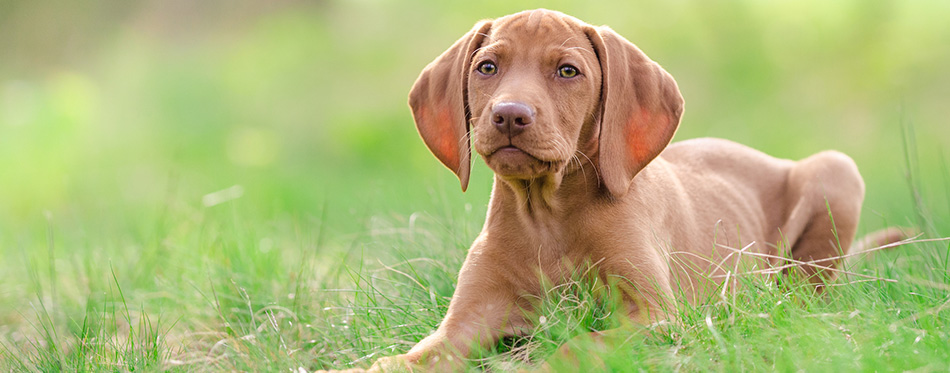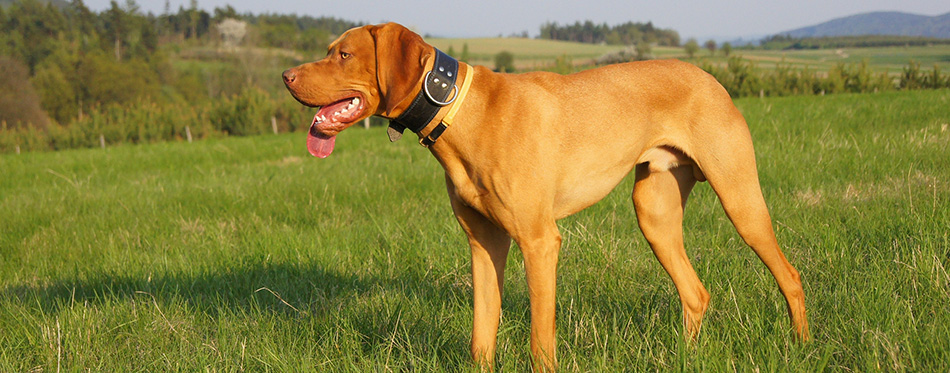There are few breeds of dog as lovely as the Vizsla. As an athletic breed, these working gundogs are devoted to their masters and thrive in an outdoor environment. However, although they’re renowned for their remarkable athletic abilities, their thin coats mean these dogs love nothing more than a warm house to snuggle up in with their family at night.
Are your weekends spent enjoying long lies and lazy days inside? A Vizsla isn’t the kind of dog for you. Only those who feel most alive when hiking or running outdoors are suitable to take on the challenge of owning a Vizsla. If you think you’ve got what it takes, read on below to find out if a Vizsla is your perfect canine companion.

History of the Vizsla
To understand the significance of the Vizsla dog, the importance of the Carpathian Basin must also be appreciated. The Carpathian Basin is a large basin in Central Europe, covering certain regions of western Slovakia, Poland, Ukraine, Croatia, and many more. The ninth century saw Hungarian tribes – otherwise referred to as Magyar tribes – conquer the region by defeating many armies, eventually establishing a Christian monarchy in the tenth century. And the Vizsla dogs, boasting exceptional hunting skills, were critical towards their success.
The Magyars did everything in their power over centuries to preserve the purity of the short-haired Hungarian Vizsla breed. After all, their toughness, speed, and ability epitomized the tribe’s core values. Primeval stone etchings spanning thousands of years of Magyar hunters surrounded by falcons and Vizsla dogs corroborate this theory. The breed enjoyed the luxuries of belonging to aristocratic owners who took it upon themselves to develop the hunting abilities of this great yellow-pointer dog breed.
In the nineteenth century, however, the Hungarian Vizsla almost became extinct as Hungarians turned their attention towards developing German Shorthaired and English pointers. Likewise, when Nazi Germany invaded Hungary in the Second World War, several Vizslas were smuggled out of the country to protect them from the Nazi campaign to purify the Aryan race. Despise their persecution over the nineteenth century, the breed lives on – largely due to Americans remarking their hunting prowess as Vizslas arrived here in the 1950s.
Quick Facts About the Vizsla
- They’re exceptional sprinters: These red-coated Hungarian gundogs possess exceptional levels of endurance. As they’re able to reach top speeds of forty miles per hour, a Vizsla is the perfect fitness buddy to join you on hikes and cycles.
- Vizslas are purebred dogs: This may come as a surprise to many Vizsla-lovers, given that it’s common knowledge Vizslas mated with German Shorthairs and English Pointers. However, over time the Vizsla has successfully passed down the same specific traits that makes it recognizable as a purebred.
- The Vizsla dog breed is registered with most kennel clubs: Given the Vizsla’s rich cultural history, they’re registered with most major kennel clubs including the UK, American, and United Kennel clubs. Their recognition by such reputable kennel clubs makes it easier to identify assured breeders to purchase Vizsla puppies from.
- Every Vizsla pup is a redhead: Unlike how puppies lose their striking blue eyes a few weeks after they’re born, Vizsla pups never lose their beautiful red fur. A quintessential Vizsla boasts warm red fur with hints of gold speckles and should even possess a red nose and red skin around their eyes to match.
- Hungarian Vizslas don’t come cheap – but there are other options available: You should expect to pay in the region of $1000 for a pedigree Vizsla. However, you can also choose to rehome Vizslas found in shelters, as unfortunately, many Vizslas end up there due to their previous owners not being able to offer them the extremely active lifestyle they required. In fact, due to the Vizslas slow mental development, members of the breed act like puppies until they reach around three years old, so they settle into new families with ease.

Things You Should Know
Have the quick facts on Vizslas above piqued your interest? Below, we’ll get into the nitty gritty and list exactly what it takes to give these lovely dogs the lifestyle they deserve.
Health
To ensure a Vizsla remains in good health, they aren’t breeds who are able to live in apartments. As much as you may want a Vizsla more than anything in the world, they would become self-destructive due to living in such a small space and may turn against you.
Otherwise, Vizslas are more prone to certain diseases than others that you should be able to identify the symptoms of in order to deal with them more effectively when the time comes.
Hypothyroidism: When a dog’s thyroid gland fails to produce enough hormones, hypothyroidism occurs. Vizslas that have underactive thyroid glands suffer from a drop in energy levels, irregular bowel movements, and exhaustion – so watch out for these. If hypothyroidism is left to develop untreated, many complications can arise including heart problems and infertility, so take your dog to the vet immediately if you notice any symptoms.
Persistent right aortic arch: This cardiovascular disease – otherwise referred to as “vascular ring anomaly” – is a common birth defect when abnormalities occur near the major blood vessels at the heart’s base. Thankfully, its symptoms are fairly easy to identify; as puppies begin to eat solid foods, this food is forced back out the mouth due to their esophagus’s dilation. This action is not as violent as vomiting, but much more passive. Surgery is recommended, so take your Vizsla pup to the vet to discuss what future actions will be required.
Progressive retinal atrophy (PRA): This umbrella term describes several inherited neuroretinal degenerations that affect the photoreceptor cells of the eye, unfortunately result in blindness over time. If a Vizsla develops PRA, that dog should not be bred in breeding programs. The first symptom of PRA is when a dog struggles to see clearly on night-time walks, so keep your eyes peeled for if your Vizsla becomes reluctant to enter dark rooms or is becoming clumsier over time.
Training
Before training begins, a trainer should be aware that Vizslas are extremely sensitive and should never be roughly or aggressively treated. However, if a Vizsla is trained well, its skills and personality will astonish its owner. Don’t expect your Vizsla to pick up on training immediately, as their slow mental development means training will take a while to kick in.
This certainly doesn’t mean that you should scrimp on training your Vizsla early on. The Vizsla’s willingness to connect to their master mean that they’ll profit from any type of one-on-one training, even if they don’t start summersaulting after a few days of training.
Undoubtedly, the best form of training is agility training. Sessions should be kept short at between five-ten minutes to keep your Vizsla’s attention span. Signing your Vizsla up to a training club to train alongside other dogs will encourage them to socialize and keep your training sessions per week regimented. Head over to our review of dog agility tunnels for more choices.
If money is tight or you live in a rural environment with no dog training nearby, the most affordable form of ability training is balancing a broomstick on a stack of books to then encourage your dog to jump over it. Another training hack that costs no money is conquering your Vizsla’s fear of the dark by constructing a mock tunnel with chairs and a blanket. Dispersing treats through your mock tunnel, poke your head through the other side to encourage your Vizsla to make their way through.
Exercise
It would be a crime to allow a noble working breed such as the Vizsla to fall into decline by not giving it the right amount of exercise. A Vizsla’s skin should contain no folds, and an owner should take it upon themselves to ensure they do not build up fat. Therefore, only active families should even consider welcoming a Vizsla into their homes, as leisurely walks around the park just won’t do for dogs of this breed.
An hour of exercise at minimum will keep the average Vizsla happy. However, Vizslas should realistically receive two hours of exercise per day for them to thrive. In relation to optimal conditions for a Vizsla to exercise in, open spaces for them to run around in are essential. Families who live far out in rural areas beside open lakes and fields are well suited to owning Vizslas; especially as Vizslas love nothing more than swimming with their unusual webbed paws.
Nutrition
As Vizslas are working dogs, providing them with the correct sustenance to go about their duties is vital for their well-being. Kibbles high in animal protein, therefore, are the only viable choice – just because dogs are omnivores doesn’t mean their health should be sacrificed due to your own eating preferences. Preferably, a Vizsla’s kibble should consist of a minimum crude protein percentage of 22% and 8% crude fat. It’s a legal requirement for these figures to appear on food packaging, so keep on searching everywhere on the packet – they’ll be there somewhere!
Given the large amount of fat Vizslas burn each day, they tend to scoff their food as soon as it’s laid out on front of them. This habit isn’t recommended for their digestive tract and may lead to your Vizsla getting an upset stomach or even suffering from bloat – a serious condition where gas builds up in a pooch’s digestive tract, causing it to expand to the point that the stomach twists, cutting of blood flow and any liquids or gas leaving. To this end, investing in a foraging mat may be a good idea to stop your Vizsla from ingesting their food too fast.
For more guides on choosing the right dog food, you may wish to check out our reviews of the best dry dog food, organic dog food, dehydrated dog food , dog food for shedding and puppy food.
Grooming
Vizslas thankfully require minimal grooming by virtue of their short, fine fur. The only reason you’ll have to even brush your Vizsla is to check for fleas every so often. Plus, brushing your dog’s fur regularly is vital for checking for unfamiliar lumps and bumps.
Otherwise, simply trim your Vizsla’s nails once per month and clear their ears weekly to keep on top of their grooming schedule. And – although your Vizsla pup will most likely hate this – you should start getting them into the habit of brushing their teeth from an early age. Never use human toothpaste and instead buy enzymatic dog toothpaste that doesn’t taste of the minty smell dogs despise.
For more help on dog grooming, you may wish to read our guides on the best dog nail grinders, dog dryers, dog clippers, dog paw washers and dog shampoo.
Temperament
These dogs cannot get enough of human company, to such an extent that Vizslas have acquired the affectionate term “Velcro dogs”. Wherever you go, you can expect your Vizsla to join you. After only a few months of owning a Vizsla pup, you’ll get used to looking down at the ground before moving, as Vizsla’s love nothing more than snuggling down at your feet – often in the most inconvenient spots. What this does mean is that Vizslas should rarely be left alone. Without a human to latch onto, they’ll become bored and self-destructive.
By virtue of a Vizsla’s evenly tempered disposition, they’re wonderful companions for older children. However, their suitability with young children is still a subject of debate amongst dog-lovers. Those who recommend bringing a Vizsla into a home with young children speak of how their ability to be light on their feet means they learn to play with young children without making contact. On the other hand, the number of dog bite injuries children inflict from Vizslas begs to differ. It’s your call; but just bear in mind that your Vizsla is still a dog that won’t understand all social cues unless properly trained and socialized.
We hope that in the course of this article it has become abundantly clear that Vizslas are good-natured dogs who will thrive in a family environment. However, we wish to reiterate that a Vizsla cannot just be kept as family dogs around the home. To reach their full potential, Vizslas must be given the best of both worlds: that is, an energetic lifestyle in the great outdoors combined with a nurturing home environment. Only then will your Vizsla be truly happy.


